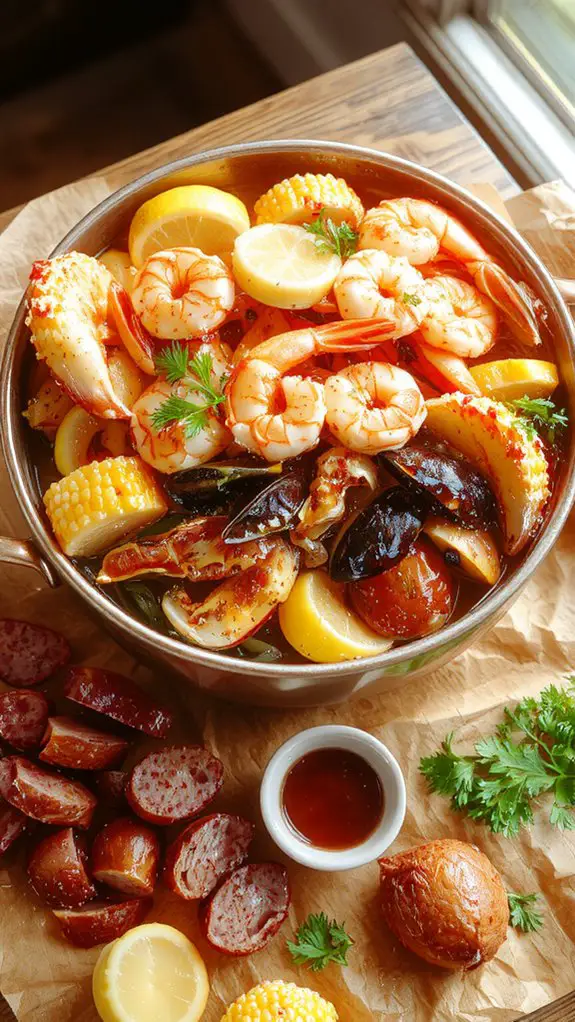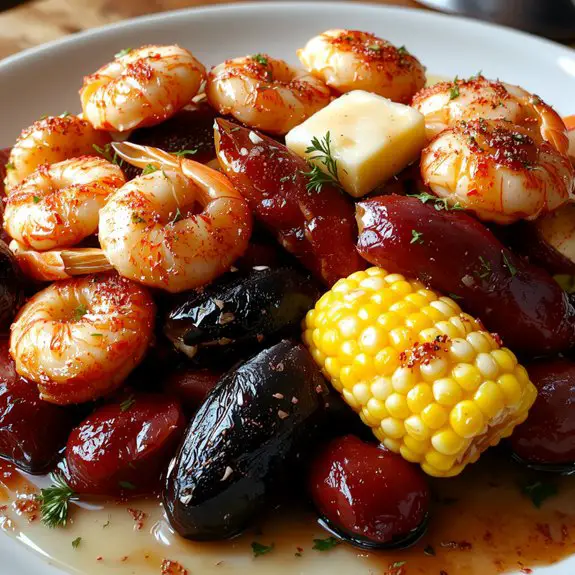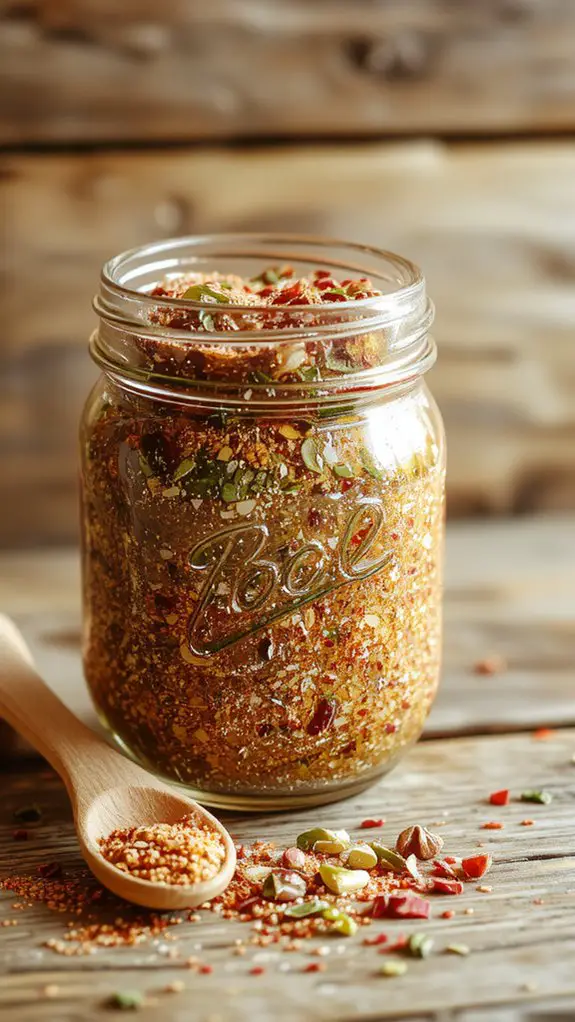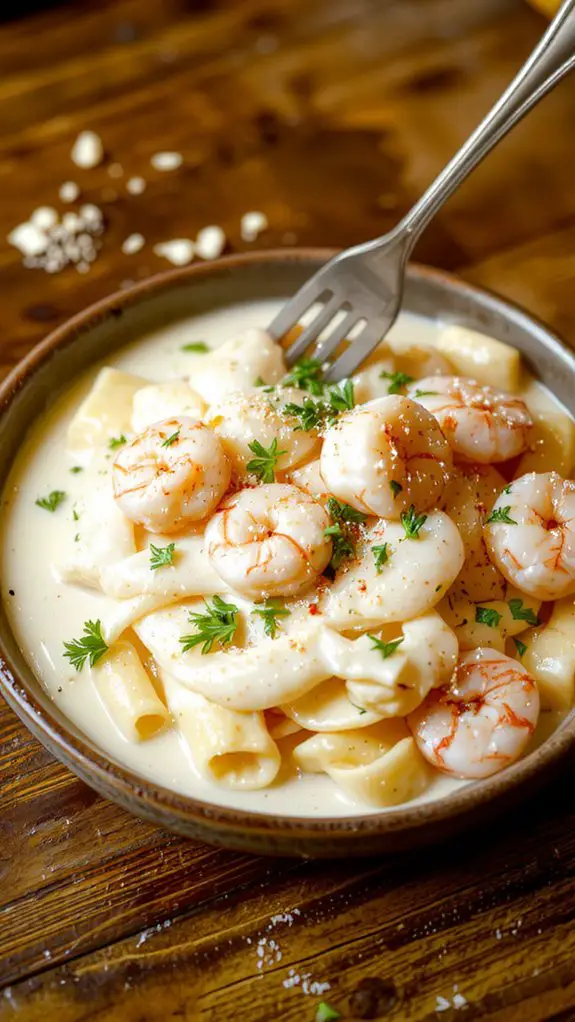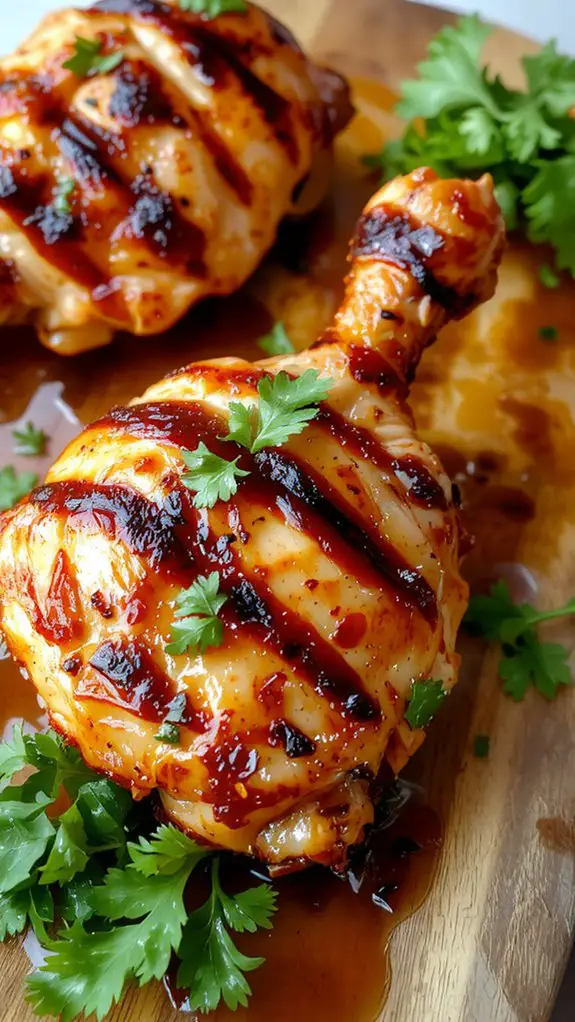Recipe
This seafood boil recipe is hands-down the best way to elevate your next gathering—or just treat yourself to something unforgettable. I’ve made this countless times, and every single bite feels like a celebration of flavors.
The secret? A perfectly balanced blend of Old Bay seasoning, fresh lemon, and garlic butter that coats every single piece of shrimp, crab, and tender potatoes. It’s messy in the best way—juicy, aromatic, and loaded with that irresistible seafood essence.
Whether you’re hosting a crowd or craving a special weekend treat, this recipe is foolproof and guaranteed to wow. Trust me, once you taste that buttery, spicy broth soaked into fresh corn and sausage, you’ll wonder why you waited so long to try it.
Let’s jump right in!
Ingredients
A seafood boil is all about fresh, bold flavors, so choosing the right ingredients is key. Here’s what you’ll need to create a show-stopping boil that’s bursting with flavor:
Proteins:
- Shrimp (1–2 lbs, large, unpeeled): Go for wild-caught if possible—the flavor is unbeatable. Keep the shells on; they add depth to the broth.
- Crab legs (1–2 lbs, snow or king): Frozen works fine, but thaw before cooking. Crack them slightly for easier eating.
- Mussels or clams (1 lb): Make sure they’re closed and fresh. Discard any that don’t open after cooking.
Optional: Add Andouille sausage (sliced) for a smoky, spicy kick.
Aromatics & Seasonings:
- Old Bay seasoning (¼ cup): The backbone of any seafood boil. Don’t skip it—it’s non-negotiable.
- Garlic cloves (6–8, smashed): Fresh is best here; it infuses the broth with incredible flavor.
- Lemons (3, halved): Squeeze them into the boil and toss the halves in for extra brightness.
- Bay leaves (2–3): Adds a subtle herbal note. Dried is fine if fresh isn’t available.
- Cajun seasoning (2 tbsp): For a little extra heat. Adjust to your spice tolerance.
Vegetables:
- Corn on the cob (4 ears, halved): Adds sweetness and soaks up the broth. Fresh or frozen both work.
- Baby potatoes (1 lb, red or yellow): Small potatoes cook evenly and hold their shape. If they’re bigger, quarter them.
Optional: Add onions (1, quartered) or celery ribs (2, chopped) for extra flavor.
Liquid:
- Water (4 quarts): Use seafood stock instead of water for an extra layer of flavor if you have it.
- Beer (1 can, optional): Add a can of lager to the broth for a malty, rich undertone.
Extras:
- Salted butter (½ cup, melted): For dipping or drizzling over the seafood. It’s a must-have.
- Fresh parsley or cilantro (1 bunch, chopped): Sprinkle over the boil just before serving for a fresh, vibrant finish.
Optional: Add hot sauce or lemon wedges on the side for customization.
How to Make the Best Cajun Seafood Boil Recipe

1. Prepare the stockpot: Fill a large stockpot about halfway with water and place it on high heat to boil. Adding a few slices of lemon or a splash of vinegar can help tenderize the seafood and enhance flavor.
*Pro Tip:* Use a pot with a strainer insert for easier draining later.
2. Season the water: Add Cajun seasoning, Old Bay, garlic cloves, bay leaves, and halved onions to the boiling water. Let the mixture simmer for about 10 minutes to infuse the broth with flavor.
*Watch Out:* Avoid adding salt separately—seasoning blends often contain enough.
3. Add potatoes and sausage: Toss in the halved potatoes and sliced smoked sausage first, as they take the longest to cook. Let them simmer for about 10 minutes until the potatoes start to soften.
*Why This Works:* Starting with hearty ingredients guarantees everything cooks evenly.
4. Incorporate corn and onions: Add the corn cobs (cut into chunks) and continue cooking for another 5 minutes. This allows the corn to absorb the flavorful broth without overcooking.
*Visual Cue:* The potatoes should be fork-tender before moving to the next step.
5. Cook the seafood: Add the shrimp, crab, and mussels to the pot. Shrimp typically cook in 3-5 minutes, while mussels will open when done.
*Watch Out:* Overcooking seafood can make it rubbery. Remove the pot from heat as soon as the shrimp turns pink and mussels open.
6. Drain and serve: Carefully lift the strainer insert or use a slotted spoon to transfer everything to a large serving platter or spread it out on a table covered with newspaper for a casual feast.
*Pro Tip:* Reserve a bit of the broth for dipping or drizzling over the seafood.
7. Season and enjoy: Sprinkle extra Cajun seasoning or drizzle melted butter over the seafood boil for added richness. Serve with lemon wedges and hot sauce on the side.
*Flexibility:* Adjust the seasoning to your taste—mild or spicy, it’s up to you!
Nutrition
Seafood boils are a flavorful dish packed with nutrients. Here’s a breakdown of the nutritional value per serving.
| Calories | Protein | Fat | Carbs | Fiber | Sugar |
|---|---|---|---|---|---|
| 450 | 35g | 15g | 40g | 5g | 6g |
Chef Tips
When preparing a seafood boil, I always recommend seasoning generously and layering flavors thoughtfully. Start by using a bold seasoning blend for the broth, then add aromatics like garlic, onion, and lemon for depth.
Don’t overlook the importance of timing—cook heartier ingredients first, like potatoes and corn, before adding delicate seafood. Finally, serve immediately to enjoy the dish at its freshest and most flavorful.
Frequently Asked Questions
Can I Use Frozen Seafood Instead of Fresh?
I’d use frozen seafood if fresh isn’t available—just thaw it properly first. Frozen seafood can work well in a boil, though you might want to adjust cooking times slightly since it’s been pre-cooked during freezing.
What Seafood Alternatives Work in a Boil?
I can use shrimp, crab legs, clams, mussels, or lobster in a boil—they’re all great. If I’m feeling adventurous, I’ll toss in crawfish or scallops. Even frozen seafood works if I don’t have fresh.
How Do I Store Leftover Seafood Boil?
I’d let it cool first, then store leftovers in airtight containers or resealable bags. I’d keep it in the fridge for up to 2 days or freeze it if I want it to last longer, reheating thoroughly before eating.
Is It Safe to Reheat Seafood Boil?
Yes, it’s safe to reheat a seafood boil if stored properly. I make sure it’s chilled quickly and reheated until steaming hot. I avoid microwaving shellfish and use a stovetop or oven to keep it flavorful.
Can I Make This Recipe Gluten-Free?
Yes, I can make this recipe gluten-free by avoiding any pre-made seasonings with gluten, using gluten-free broths or sauces, and ensuring all ingredients are labeled gluten-free. I’ll double-check packaging to stay safe.

